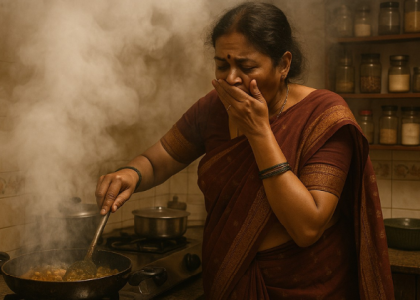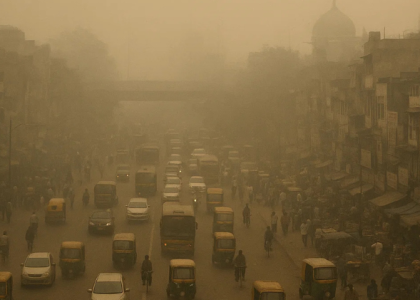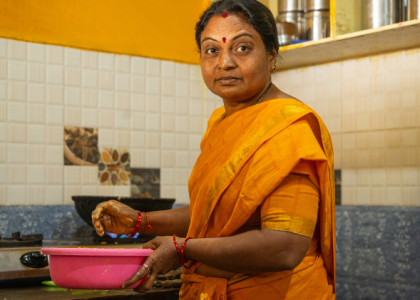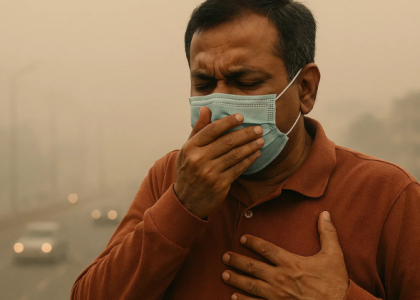It’s not just what you eat. It’s what you breathe — and what’s in your food. Pollution and pesticides may be silently damaging your heart.
For many of us from South Asian backgrounds, heart disease is already a major concern. But while we focus on diet, exercise, and controlling diabetes, we often overlook two important threats to our heart health: air pollution and pesticides.
A recent review in the journal Circulation: Heart Failure warns that South Asians face a potential “epidemic of heart failure” that could have dramatic health, social, and economic consequences. Let’s explore what these environmental factors mean for your heart and what you can do to protect yourself and your loved ones.
What the Science Says
Air Pollution and Your Heart
The air in many South Asian cities contains tiny particles that can harm your health. According to the World Health Organization (WHO), cities like Delhi, Lahore, Dhaka, and Kathmandu regularly rank among the world’s most polluted. In fact, 21 of the 30 most polluted cities in the world are in India, 5 in Pakistan, and one in Bangladesh.
Here’s how pollution affects your heart:
- Tiny pollution particles enter your lungs when you breathe
- The smallest particles pass into your bloodstream
- These particles cause inflammation in your blood vessels
- Over time, this leads to hardened and narrowed arteries
- Your heart has to work harder to pump blood
Research published in the Journal of the American College of Cardiology shows that exposure to air pollution increases the risk of:
- High blood pressure
- Heart attacks
- Heart failure
- Irregular heartbeat
- Blood clots
Think of it this way: Just as smoking damages your heart, breathing polluted air does similar harm — but you can’t choose not to breathe!
Pesticides and Your Heart
Many fruits and vegetables in South Asia are treated with pesticides to protect them from insects and disease. While these chemicals help grow more food, some may pose risks to heart health.
Studies from the Mayo Clinic suggest that certain pesticides can:
- Interfere with your heart’s normal rhythm
- Increase inflammation throughout your body
- Raise blood pressure
- Contribute to diabetes risk (which further harms heart health)
The Indian Council of Medical Research has found that many common vegetables in local markets contain pesticide residues above safe limits.
Why South Asians Are at Greater Risk
Several factors make air pollution and pesticide exposure especially concerning for South Asians:
Environmental factors:
- South Asia has 42 of the world’s 50 most polluted cities, according to the WHO
- Dense population means more exposure to traffic emissions
- Seasonal crop burning creates severe air quality problems
- Limited regulations on pesticide use in many areas
- Traditional cooking methods using wood or coal add to indoor air pollution
Health factors:
- South Asians already have higher rates of heart disease at younger ages (10-15 years earlier than other groups)
- Diabetes (common in our communities) multiplies pollution risks
- Belly fat increases inflammation, making pollution effects worse
- Many people lack awareness of these environmental risks
The Circulation: Heart Failure review highlights that South Asians typically develop heart disease about a decade earlier than other ethnic groups, and face a four times higher risk of heart disease compared to white populations. When combined with environmental factors like air pollution, this creates what health experts call a “perfect storm” for heart damage.
Warning Signs You Shouldn’t Ignore
Watch for these symptoms, especially during high pollution days or after eating conventionally grown produce:
Short-term warning signs:
- Shortness of breath that seems worse than usual
- Tightness or discomfort in your chest
- Unusual tiredness after normal activities
- Dizziness or lightheadedness
- Rapid or irregular heartbeat
Long-term warning signs:
- Gradually worsening breathing problems
- Swelling in feet, ankles, or legs
- Increased blood pressure readings
- Feeling tired even after proper sleep
- Frequent coughing that won’t go away
If you notice these symptoms, especially on days with visible pollution or smog, talk to your doctor about possible connections to environmental factors.
What You Can Do to Protect Your Heart
While we can’t completely avoid air pollution and pesticides, we can take steps to reduce their impact on our health:
For Air Pollution:
When outdoors:
- Check daily Air Quality Index (AQI) levels using smartphone apps
- Wear a good-quality mask (N95 or equivalent) on high pollution days
- Avoid outdoor exercise during peak pollution hours (early morning and evening)
- Take indoor exercise breaks instead of long outdoor sessions on bad air days
At home:
- Use air purifiers with HEPA filters in bedrooms and living areas
- Keep windows closed during high pollution days
- Grow air-cleaning indoor plants like snake plant, peace lily, or aloe vera
- Switch from wood/coal cooking to cleaner alternatives when possible
- Use exhaust fans while cooking
For Pesticides:
When buying and preparing food:
- Wash fruits and vegetables thoroughly under running water
- Soak produce in water with a pinch of salt or baking soda for 15-20 minutes
- Remove outer leaves of leafy vegetables like cabbage and lettuce
- Peel fruits when possible (but recognize that nutrients are lost)
- Buy organic when available and affordable, especially for heavily sprayed items
- Grow a small kitchen garden with a few herbs and vegetables if space allows
For Overall Heart Protection:
- Get regular heart check-ups, especially if you live in a polluted area
- Manage other risk factors like diabetes, high blood pressure, and cholesterol
- Take prescribed medications consistently
- Stay physically active (indoors when air quality is poor)
- Eat a heart-healthy diet rich in antioxidants (which help fight pollution damage)
Take Care of Your Heart — and Your Family’s
Environmental risks affect everyone in your household, but some family members may be more vulnerable:
Extra protection for vulnerable family members:
- Children’s developing hearts and lungs are more sensitive to pollution
- Elderly parents may already have weakened hearts
- Pregnant women need to protect both their hearts and their babies
- People with existing heart or lung conditions need extra precautions
Consider these family actions:
- Share air quality apps with family members
- Help elderly relatives clean their fruits and vegetables properly
- Discuss indoor air purifiers as family gifts rather than luxury items
- Talk about environmental heart risks in your family WhatsApp groups
- If you have relatives still living in highly polluted areas of South Asia, share this information with them
Small Steps Make a Difference
Remember, you don’t need to make all these changes at once. Even small steps to reduce your exposure to air pollution and pesticides can help protect your heart over time.
As the Circulation: Heart Failure review emphasizes, urgent interventions are needed to flatten the curve of heart failure in South Asia. By taking personal precautions and supporting broader environmental improvements, you can help protect your heart and the hearts of those you love.
Your heart works hard for you every day. These simple protective measures can help it keep beating strong for years to come.
This article includes information from the World Health Organization, Journal of the American College of Cardiology, American Heart Association, Indian Council of Medical Research, and Mayo Clinic research on environmental factors and heart health. Key findings incorporated from “The Upcoming Epidemic of Heart Failure in South Asia” published in Circulation: Heart Failure, October 2020.




